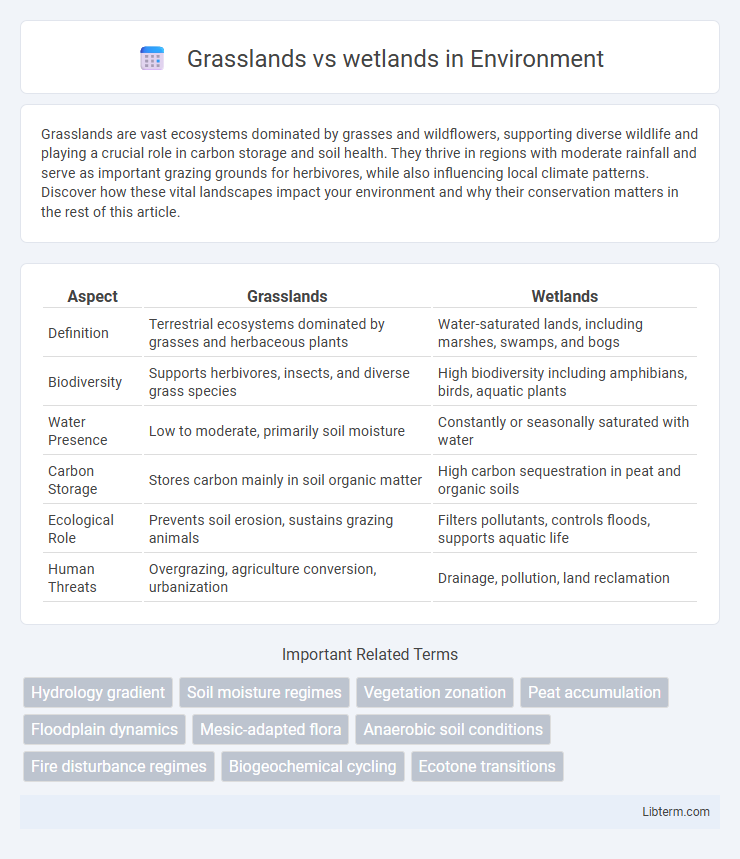Grasslands are vast ecosystems dominated by grasses and wildflowers, supporting diverse wildlife and playing a crucial role in carbon storage and soil health. They thrive in regions with moderate rainfall and serve as important grazing grounds for herbivores, while also influencing local climate patterns. Discover how these vital landscapes impact your environment and why their conservation matters in the rest of this article.
Table of Comparison
| Aspect | Grasslands | Wetlands |
|---|---|---|
| Definition | Terrestrial ecosystems dominated by grasses and herbaceous plants | Water-saturated lands, including marshes, swamps, and bogs |
| Biodiversity | Supports herbivores, insects, and diverse grass species | High biodiversity including amphibians, birds, aquatic plants |
| Water Presence | Low to moderate, primarily soil moisture | Constantly or seasonally saturated with water |
| Carbon Storage | Stores carbon mainly in soil organic matter | High carbon sequestration in peat and organic soils |
| Ecological Role | Prevents soil erosion, sustains grazing animals | Filters pollutants, controls floods, supports aquatic life |
| Human Threats | Overgrazing, agriculture conversion, urbanization | Drainage, pollution, land reclamation |
Introduction to Grasslands and Wetlands
Grasslands are vast open areas dominated by grasses and herbaceous plants, supporting diverse wildlife and playing a crucial role in carbon storage and soil conservation. Wetlands are unique ecosystems characterized by saturated soils and abundant water, providing critical habitats for amphibians, birds, and aquatic species while acting as natural water filters and flood buffers. Both grasslands and wetlands contribute significantly to biodiversity, climate regulation, and ecosystem services essential for environmental health.
Defining Characteristics of Grasslands
Grasslands are characterized by vast open spaces dominated by grasses, with few trees or shrubs, and experience moderate rainfall between 250 to 750 millimeters annually. These ecosystems support herbaceous plants adapted to periodic drought and fire, providing habitat for grazing animals such as bison and antelope. Unlike wetlands, grasslands have well-drained soils and lack standing water for extended periods, influencing their plant and animal communities.
Key Features of Wetlands
Wetlands are characterized by saturated soils, standing water, and a diversity of hydrophytic vegetation adapted to fluctuating water levels. These ecosystems serve crucial functions such as water purification, flood regulation, and habitat provision for numerous amphibians, birds, and aquatic plants. Unlike grasslands dominated by herbaceous plants and well-drained soils, wetlands sustain biodiversity through their unique hydrology and nutrient cycling.
Climate and Geographic Distribution
Grasslands primarily occur in temperate and tropical regions with moderate rainfall between 250-750 mm annually, supporting vast ecosystems across North America, South America, and Eurasia. Wetlands are distributed globally, often in coastal, riverine, and inland basin areas with saturated soils, playing a crucial role in carbon sequestration and water purification in regions like the Mississippi River Delta, the Amazon basin, and the Siberian tundra. Climate influences grasslands' susceptibility to drought and wildfires, while wetlands' hydrology depends on precipitation, groundwater, and tidal patterns, affecting their biodiversity and ecosystem services.
Biodiversity Comparison
Grasslands support a rich diversity of grasses, herbaceous plants, and grazing animals, playing a critical role in sustaining large herbivore populations and numerous ground-nesting bird species. Wetlands harbor a unique assemblage of aquatic plants, amphibians, fish, and waterfowl, serving as crucial breeding grounds and migration stopovers for many species. Compared to grasslands, wetlands often exhibit higher biodiversity per unit area due to their complex hydrology and nutrient-rich environments that support a wide array of flora and fauna.
Ecosystem Services Provided
Grasslands deliver critical ecosystem services including carbon sequestration, soil erosion control, and habitat provision for pollinators and grazing wildlife. Wetlands offer essential flood regulation, water purification, and biodiversity support, sustaining numerous aquatic and terrestrial species. Both ecosystems play vital roles in climate regulation and nutrient cycling, with wetlands particularly effective at filtering contaminants and grasslands excelling in carbon storage.
Adaptations of Flora and Fauna
Grassland flora exhibit deep root systems and narrow leaves to conserve water and withstand drought, while fauna such as bison and pronghorn have evolved grazing behaviors and speed for predator evasion. Wetland plants like cattails and mangroves possess specialized roots for oxygen absorption in waterlogged soils, and animals including amphibians and waterfowl display adaptations such as webbed feet and permeable skin for aquatic environments. These distinct adaptations enable survival and reproduction in the contrasting conditions of grasslands and wetlands.
Human Impact and Land Use
Human activities have significantly altered grasslands and wetlands through agriculture, urbanization, and industrial development. Grasslands face intense pressure from farming and grazing, leading to habitat fragmentation and soil degradation, while wetlands are often drained or filled for real estate and infrastructure projects, resulting in loss of biodiversity and disrupted water cycles. Effective land use management and restoration efforts are critical to mitigate these impacts and preserve the ecological functions of both ecosystems.
Conservation Challenges
Grasslands face conservation challenges such as habitat fragmentation, invasive species, and unsustainable agricultural practices that lead to biodiversity loss and soil degradation. Wetlands are threatened by drainage for agriculture, urban development, pollution, and climate change, resulting in diminished water quality and loss of critical habitats for wildlife. Both ecosystems require targeted management strategies to preserve their ecological functions and support species diversity.
Future Outlook for Grasslands and Wetlands
Grasslands and wetlands face contrasting futures shaped by climate change, land use, and conservation efforts. Grasslands are predicted to shrink due to agricultural expansion and urbanization, threatening biodiversity and carbon storage, while wetlands may experience fluctuating water levels and increased pollution, impacting their role in flood control and habitat provision. Sustainable management and restoration initiatives are critical for enhancing resilience and preserving ecosystem services in both biomes.
Grasslands Infographic

 libterm.com
libterm.com